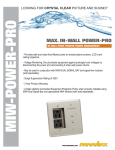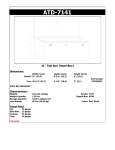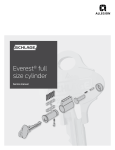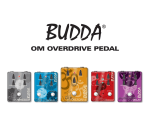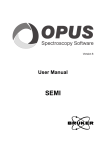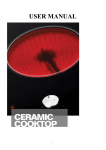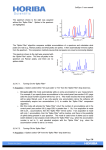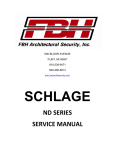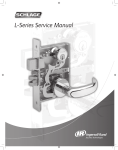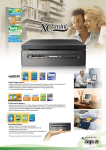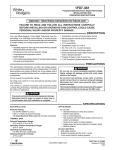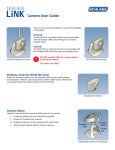Download Front Cover
Transcript
Front Cover Conventional Cylinders Service Manual Contents Introduction...................................................................................................................................................................1 Key Control ...................................................................................................................................................................2 Open Keyways ..............................................................................................................................................................2 Restricted Keyways ......................................................................................................................................................2 Primus ® Integration ....................................................................................................................................................2 Mechanical Overview ...................................................................................................................................................3 Traditional Cylinder .......................................................................................................................................................3 Modular Cylinder ...........................................................................................................................................................3 Traditional Cams ...........................................................................................................................................................3 Modular Cams...............................................................................................................................................................3 Modular Cylinders ........................................................................................................................................................4 Key-In-Knob to Modular Mortise and Rim Cylinder Conversion....................................................................................4 Modular Housing Interchangeability..............................................................................................................................4 Rekeying When You Have the Old Key (no master keying) .......................................................................................5 Master Keying ...............................................................................................................................................................5 Rekeying When You Have No Keys .............................................................................................................................6 Key Bitting Specifications ...........................................................................................................................................7 Pins and Springs ..........................................................................................................................................................7 Cutting Everest™ Keys on the Blue Punch ...............................................................................................................8 Upgrading to New Top Jaw ..........................................................................................................................................9 Red Knob Operation .....................................................................................................................................................9 Black Lever Operation...................................................................................................................................................9 Upgrade Package 40-074 .............................................................................................................................................9 Upgrading Machines With a Red Knob .........................................................................................................................9 Upgrading Machines With a Black Lever ......................................................................................................................9 Tips for Cutting Everest™ Keys ................................................................................................................................10 Key Blanks ..................................................................................................................................................................11 Operating Keys ...........................................................................................................................................................11 Control Keys................................................................................................................................................................11 Cut Keys......................................................................................................................................................................11 C Family Open Keyways .............................................................................................................................................11 i Conventional Cylinders Service Manual ii Conventional Cylinders Service Manual Larger Key Bow Introduction Everest™ is the name given to a new family of patented key products by Schlage. Everest products are distinguished by the patented undercut groove milled into the right side of the key blade. Patented Undercut Groove PAT. 5,715,717 The first product in this family was the small format interchangeable core (SFIC) introduced in November 1998 to retrofit 7-pin Best ® style IC products. A different service manual (MS-C75) is devoted to SFIC. This manual covers the Schlage Everest cylinder, which is available in mortise, rim, key-in-knob and key-inlever versions. The Everest cylinder is also available in Schlage’s 23-030 full size interchangeable core. Undercut Groove Keyway and Everest Logo on Plug Face Except for the keyway and special pin which checks for the lip on the side of the key section, Everest cylinders are virtually identical to Schlage Classic™ cylinders with the C keyway, which have been around since 1935. Locksmiths and users get the benefits of the new patent without the need to invest in new pin kits, key machines or additional service equipment. However, a new top vise jaw is needed for the Blue Punch to hold all Everest C Family open key sections. A separate section of this manual provides details on how to upgrade the old Blue Punch. Hole in Cylinder Shell for Check Pin Note: D Family restricted keys can be cut on a different key bitting punch (40-099) because the top of the key blade is not straight. 1 Conventional Cylinders Service Manual Key Control Primus ® Integration Since the late 1960’s patents on keys have been used primarily to prevent unauthorized key duplication. This is the case with Schlage’s new Everest™ D Family keyways but the C Family open keyways are a major departure from this tradition. Primus® cylinders are also available with Everest keyways. The Everest Primus keys are downward compatible to operate the conventional Everest cylinders covered in this manual. See the Schlage High Security Cylinders & Key Control Service Manual (SC-GN-1001) for details on Everest Primus cylinders. Open Keyways Everest C Family Keyways are protected by U.S. utility patents 5,715,717 and 5,809,816 against unauthorized manufacture and distribution. However, the C Family keyways are readily available to the end user for fast and easy key duplication without any formalities. All C keyways are considered “open” keyways which means they can be stocked and sold by all locksmiths and contract hardware dealers. The purpose of the Everest C keyways is to guarantee the end-user genuine Schlage quality replacement keys and to provide commercial locksmiths and contract hardware dealers a group of keyways not available in home centers or retail key stands. Everest C Family keyways are the default keyways for new Schlage master key systems. Restricted Keyways For end-users who want restricted keys with patent protection, Schlage offers its Everest D Family keyways. Everest D Family keyways are protected by the same patents and require a letter of authorization from the end user. The difference between the C and D Families is just the keyway. Despite the fact that Everest D Family keyways are restricted keyways, they are still serviced in the same manner as the C Family keyways. However, D Family restricted keys can be cut reliably on key bitting punch 40-099 because the top of the blade is not straight. The keyway for each restricted D Family job is selected by Schlage and registered to the end user. Everest restricted key blanks, cut keys, cylinders and plugs are drop shipped directly to the end user (or a location specifically authorized by the end user). This creates positive key control by preventing dealers and distributors from having access to keys and cores without the end user’s permission. 2 A portion of the undercut groove is milled away on all conventional Everest keys to prevent them from being altered to operate an Everest Primus cylinder. Lip to lift check pin Lip removed to prevent Primus operation Conventional Cylinders Service Manual Mechanical Overview Tumbler Springs Cylinder Cross Section Top pins Shell Tailpiece Master Pins (as needed) Bottom Pins Key Locked Plug Check Pin Spring Check Pin Traditional Cylinder Everest and Primus Retainer Cap Retainer Cap Pin Retainer Cap Pin Spring Modular Cylinder Classic Everest and Classic Horizontal Traditional Cams Everest and Primus Unlocked Vertical Modular Cams Classic Mortise cylinders use the Primus cam with one screw. For cylinder housing sizes 1¹⁄₄, 1¹⁄₂, 1³⁄₄” For cylinder housing sizes 1¹⁄₈, 1³⁄₈, 1⁵⁄₈” Modular cylinder cams may be used with Classic, Everest and Primus key sections. Use appropriate cam for cylinder housing size. 3 Conventional Cylinders Service Manual Modular Cylinders Introduced in April 2010, the Schlage modular cylinder provides easy convertibility between key-in-lever to mortise and rim cylinders. These benefits make Schlage cylinder inventory flexible, reduce the size and cost of inventory, improve customer lead time, and increase customer satisfaction. With a few modular components in stock, the cylinder type and finish required will always be on hand. The modular cylinder accepts a tailpiece or a mortise cam. Product line availability: A, AL, B, CL, D, H, L, ND, S, S200, Kryptonite (PL, KS, KC), and Rim (standard and lockout). All competitive locks that accept Everest Primus® will also accept the modular cylinders. Key-In-Knob to Modular Mortise and Rim Cylinder Conversion Modular Key-In-Knob Cylinder Modular Mortise Cylinder Modular Rim Cylinder Modular Housing Interchangeability Housing 4 Cam Cam Screw Cam L583-474 or L583-475 Plug Extension Part Number Size B520-721 1¹⁄₈" L583-474 B520-690 — B520-722 1¹⁄₄" L583-475 B520-690 — B520-723 1³⁄₈" L583-474 B520-691 B590-298 B520-724 1¹⁄₂" L583-475 B520-691 B590-298 B520-725 1⁵⁄₈" L583-474 B520-692 B590-299 B520-726 1³⁄₄" L583-475 B520-692 B590-299 Part Number Cam Screw, 1” B520-692 Cam Screw, ³⁄₄” B520-691 Plug Extension B520-299 Cam L583-474 or L583-475 1³⁄₄" Plug Extension B520-298 1⁵⁄₈" 1¹⁄₂" Cam Screw, ¹⁄₂” B520-690 Cam L583-474 or L583-475 1³⁄₈" 1¹⁄₄" 1¹⁄₈" housing Conventional Cylinders Service Manual The following instructions assume that the reader has basic experience pinning conventional cylinders. The difference with Everest™ cylinders is the check pin and spring located in the special chamber on the bottom of the plug. If using a key to remove the plug, the key will hold both the check pin and check pin spring in place. Rekeying When You Have the Old Key (no master keying) A setup key can be made by cutting a key blank to a 9 depth in all positions. When the steeples between the cuts are removed, the setup key can hold the check pin in place when removing the plug of a shimmed cylinder. #9 Depth Key for Setup Key 1. Remove the cam, tailpiece or other type of plug retainer. 2. Insert the old key and turn it slightly in either direction. 3. Push the plug out gently with a plug follower. 1. Insert any operating key and turn it slightly in either direction. Gently push the plug out with a plug follower. 2. Keeping the old key in the plug, discard the old pins. Key holds check pin in place 4. While the key is still in the plug to hold the check pin in place, discard the old pins. 5. Hold the check pin in the plug with your finger or thumb. Remove the old key and insert the new key. 6. The new key holds check pin in place while the bottom pins are installed and the plug is put back into the shell. 7. Reinstall the cam, tailpiece, etc. Key holds check pin in place 3. Hold the check pin in position with a finger or thumb. Remove the old key and insert the setup key. If you are certain that the cylinder was not previously master keyed, skip to step 5. 4. IMPORTANT: Clear the cylinder shell of any remaining master pins. If master pins remain in the shell, the following problems may occur: • A key cannot be inserted or removed • One or more springs may get crushed and cause a future lockout • Additional keys will operate the cylinder. Lip raises check pin and holds it in plug. Slowly back the follower out of the shell. Replace any weak or damaged springs. Load the proper size top pin based on the plug total (bottom pin + any master pins). A plug follower with a groove will help guide each spring and top pin into its chamber as you push the follower in from the back of the shell. (The 40-116 shell loading tool can make this process easier.) Master Keying 5. Install new bottom and master pins into the plug. The master keying capacity of full size Everest™ cylinders is the same as Schlage Classic™ cylinders: 4,096 theoretical changes per keyway using two step progression. The MACS is 7. When master keying Everest cylinders, Schlage recommends using a setup key to reinstall the loaded plug. 6. Orient the plug so it is slightly turned with respect to the shell. Gently push the plug into the shell, pushing the plug follower out. 7. Test all keys for smooth operation. 8. Reinstall the cam, tailpiece, etc. 5 Conventional Cylinders Service Manual Rekeying When You Have No Keys When no key is available, use standard locksmith techniques to shim the cylinder open. However, the check pin must be taken into account. Follow these steps: 1. Using a pick or key blank, shim the six pins as usual. After the last pin is neutralized, the plug still cannot rotate or slide out because the check pin is engaged. 2. Leaving the shim in place, insert a setup key with no steeples between the 9 depth deep cuts. This unlocks the check pin and will also keep it from springing out of the plug in step 4. 3. Use the setup key to turn the plug slightly in either direction and remove the shim. For removing plug when shimming 4. Push the plug out gently with a plug follower. 5. While the setup key is still in the plug, discard the old pins. If you are certain that the cylinder was not previously master keyed, skip to step 7. 6. IMPORTANT: Clear the cylinder shell of any remaining master pins. If master pins remain in the shell, the following problems may occur: • A key cannot be inserted or removed • One or more springs will get crushed and cause a future lockout • Additional keys will operate the cylinder. Slowly back the follower out of the shell. Load the proper size top pin based on the plug total (bottom pin + any master pins). A plug follower with a groove will help guide each spring and top pin into its chamber as you push the follower in from the back of the shell. (The 40-116 shell loading tool can make this process easier.) 7. If you are master keying, leave the setup key in the plug. Otherwise, hold the check pin in position with your finger or thumb while removing the setup key and inserting the new operating key. 8. Install the new pins in the plug. 9. Orient the plug so it is slightly turned with respect to the shell. Gently push the plug into the shell, pushing the follower out. 10. Test all keys for smooth operation. 11. Reinstall the cam, tailpiece, etc. 6 Conventional Cylinders Service Manual Key Bitting Specifications The following specifications are the same for Schlage Classic™ keys, including Primus® 1.012" Code Card .8558" C45 .6996" for HPC 1200CM Code Machine .5434" .3872" MACS = 7 .231" Increment: 100° 0.15" Progression: Two Step Blade Width: .343" Depth Tolerance: Spacing Tolerance: + .002" - 0 ± .001" .031" 1 2 3 4 5 Root Depths 0 .335" 1 .320" 2 .305" 3 .290" 4 .275" 5 .260" 6 .245" 7 .230" 8 .215" 9 .200" 6 Pins and Springs Bottom Pins Master Pins Top Pins Size Length Part No. Size Length Part No. Size Length Part No. Application 0 .165" 34-300 2 .030" 34-202 1 .235" 34-101 Plug total = 0, 1, 2, 3 1 .180" 34-301 3 .045" 34-203 2 .200" 34-102 Plug total = 4, 5, 6 2 .195" 34-302 4 .060" 34-204 3 .165" 34-103 Plug total = 7, 8, 9 3 .210" 34-303 5 .075" 34-205 4 .225" 34-304 6 .090" 34-206 5 .240" 34-305 7 .105" 34-207 6 .255" 34-306 8 .120" 34-208 7 .270" 34-307 9 .135" 34-209 8 .285" 34-308 Tumbler Spring C503-113 9 .300" 34-309 Check Pin 34-007 Check Pin Spring C603-951 Cap Pin C503-116 Cap Pin Spring C503-115 Other Pins and Springs Description Part No. 7 Conventional Cylinders Service Manual Cutting Everest™ Keys on the Blue Punch Handle In the close-up illustrations of the vise, notice the different positions of the top jaw required to engage the grooves and seat the different shapes of Schlage key sections properly. L-Handle Depth Bar Key Gauge Die Carriage Bottom Jaw Left end of vise Cover Plate Obverse Key Sections C, CE, E, EF, F, FG, G, H, J, K, L Depth Number Red Knob Top Jaw Bottom Jaw Clamp Into Groove Between Ribs Key Stop The original version of this popular key machine was developed in the mid-1970’s. Pro-Lok® is the most recent in the succession of companies that have manufactured the machine. Even if you have what appears to be an original Schlage punch (40-126), it was made by one of the earlier companies. The basic principles are the same for all versions of the machine, but there are minor differences in the vise jaws which affect the machine’s ability to cut Everest C Family keys. Machines made before July 1999 were not designed to hold Everest keys. Most of these machines have a thin top vise jaw made of stamped steel. Some machines will hold Everest keys, except sections with “45” in the designation (such as C145). Even the first generation solid steel jaw was produced before Everest keys existed and must be replaced. You may be able to alter your old style jaw by slightly elongating the hole, so it can travel far enough to engage in C145’s groove. However, this solution should only be a temporary measure until you install the 40-074 upgrade package with the properly shaped top jaw. Elongate 8 Loosen knob and lift jaw. Most Everest Key Sections: C100, C120, C123, C124, C135, C150 Loosen knob and lift jaw toward top of key blade. Everest "45" Sections: C145, C245, C345 Not only must the top jaw engage in different places up and down the side of the various key sections, but the lever or knob screw must be tightened or loosened substantially. Loosening and tightening the lever or knob screw allows enough travel in the top jaw to accommodate the difference in thickness between Classic™ and Everest key sections, and to adjust for the angles at which the top jaw sits. Conventional Cylinders Service Manual Upgrading to New Top Jaw Red Knob Operation Upgrading Machines With a Red Knob Tighten the red knob on the Obverse key sections or loosen it enough to let the top jaw move up to grab into the high groove of C145, or anything in between. 1. Unscrew the old knob. Black Lever Operation Pro-Lok changed the red knob to a black clutching lever in 1998, before Everest™ keys existed. The lever can only swing about 180° before hitting the body of the machine. If the Blue Punch is used only to cut one type of Schlage key section, the lever’s travel may be set for fast secure clamping every time. The black lever does not allow the top jaw to travel from its lowest position (for Obverse keys), to an intermediate position (for clamping most of the Everest C Family keys), to the highest position required (for C145). Commercial locksmiths who cut a variety of Schlage key sections daily may find the continuous lever adjustment inconvenient. On most machines, the lever must be specifically adjusted for each of the three clamping positions. Use the following procedure to back the screw out for Everest keys or to tighten the screw for Obverse keys: 1. Lift the lever against spring pressure to disengage it from the screw. 2. While disengaged, swing the lever to the left or right without turning the screw. 3. Let go of the lever and it snaps back into engagement with the screw. Upgrade Package 40-074 A newly designed top jaw, red knob, spring, finishing washer and regular washer can be obtained from your Schlage or Pro-Lok distributor. Changing the top vise jaw has no effect on the accuracy of the machine. If the machine exhibits mechanical problems or cannot cut keys accurately, please contact your Pro-Lok distributor to arrange for your machine to be rebuilt. 2. Remove the old top jaw. 3. Install the new pieces. Install the jaw so the end with the longer angled portion is toward you. The end with the shorter angle has a lip to engage in the groove of the key section. 4. Screw on the new red knob. Long Angle Upgrading Machines With a Black Lever 1. Swing the lever as far to the right as it will go. Lift up against spring pressure to disengage it from its screw. 2. Swing the lever back as far to the left as it will go and let it down to engage the screw. 3. Repeat this process as many times as necessary to unscrew the screw completely and remove the lever. A hex wrench may be helpful. 4. Remove the lever, spring, washer and top jaw. 5. Install the new jaw so that the end with the longer angled portion is toward you. The end with the shorter angle engages the groove in the key milling. 6. Reinstall the black lever or install the new red knob depending on your preference: The red knob screws into place. If reinstalling the black lever, use an Allen wrench to start the screw, then reverse the process used to remove the lever. To adjust the lever's final position and rotation, clamp a single key or key blank of the key section you will cut most frequently. Hex Socket Red Knob Finishing Washer Spring Lift Up Against Spring Pressure While Backing Screw Out Washer Top Jaw 40-074 9 Conventional Cylinders Service Manual Tips for Cutting Everest™ Keys After cutting several keys of each key section the procedure will become familiar. However, for the first few keys, please observe these important details: • Push the die carriage all the way to the right before inserting a key blank. If you clamp an Everest key before moving the carriage, its large bow may prevent the carriage from travelling far enough to allow the first cut to be correctly positioned. (Cut position will begin at #2 and incorrectly cut the key.) • Closely observe the proper engagement of the top jaw into the key section. If the jaw clamps on the surface of a rib or into the very bottom relief on an Everest key, the key jaw is not able to square up the blank in the vise, incorrectly cutting the key. C124 C124 and C135 have tiny grooves. Be sure jaw engages into a groove. 10 C145 The position of the groove on C145, C245 and C345 blanks requires loosening the knob and pushing the jaw toward the cutter to securely engage the groove. Conventional Cylinders Service Manual Key Blanks Operating Keys DO NOT DUPLICATE PAT. 5,715,717 Front DO NOT DUPLICATE PAT. 5,715,717 PAT. 5,715,717 35-002 Standard for D Family Optional for C Family 35-009 Standard Front for C Family Back 35-002 and 35-009 Back Control Keys 35-015 Optional Plain Bow for C and D Families Cut Keys C O N T RO L DO NOT DUPLICATE PAT. 5,715,717 PAT. 5,715,717 To order cut keys: Change "35" prefix to "48" or "49" 48 = Change keys and random or stock cut keys 49 = Factory master level key, including control keys 35-003 (Front) 35-003 (Back) C Family Open Keyways All-Section Key C000 Multi-Section Keys C100 C200 Multi-Section Keys Multi-Section Keys C150 C134 C145 C135 New keyway systems begin here and continue to the right. C120 C125 C124 C230 C123 C234 C235 C245 C345 Keyways and Single Section Keys 11 Conventional Cylinders Service Manual 12 Conventional Cylinders Service Manual 13 Conventional Cylinders Service Manual 14 Back Cover




















